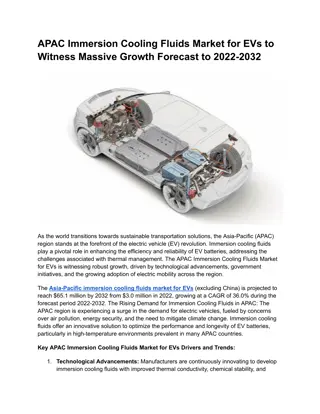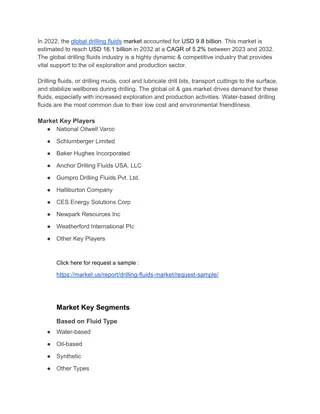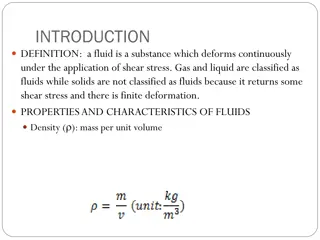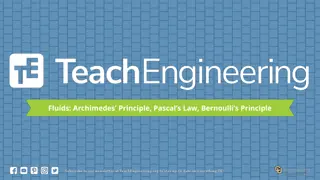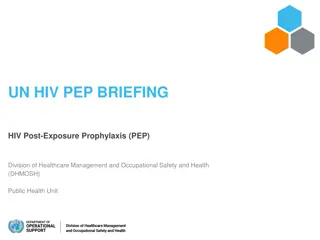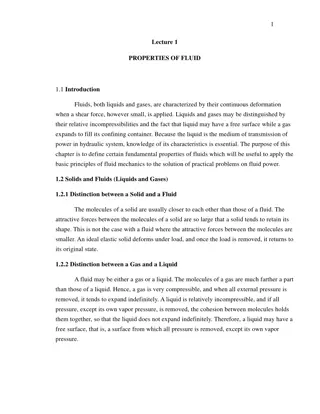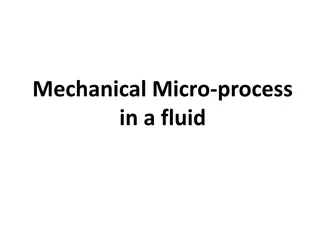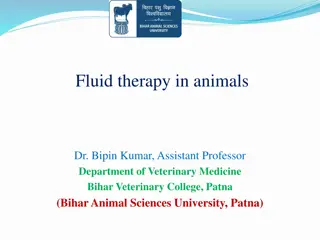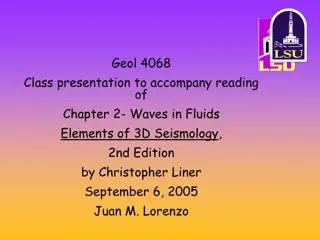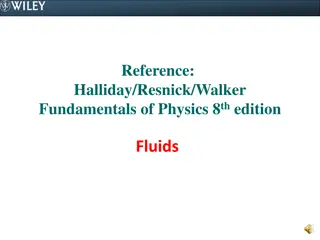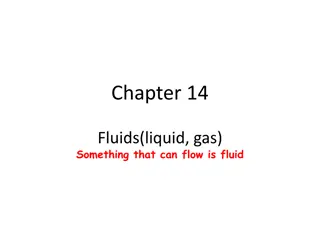Understanding Fluids: A Comprehensive Review
Explore the properties of fluids including their behavior, density, pressure, and forces through a series of questions and explanations. From identifying fluids at room temperature to understanding buoyant forces, this review covers essential concepts in fluid mechanics.
Download Presentation

Please find below an Image/Link to download the presentation.
The content on the website is provided AS IS for your information and personal use only. It may not be sold, licensed, or shared on other websites without obtaining consent from the author. Download presentation by click this link. If you encounter any issues during the download, it is possible that the publisher has removed the file from their server.
E N D
Presentation Transcript
Which of the following is a fluid at room temperature? 1. helium 2. wood 3. iron 4. gold 0% 0% 0% 0% iron helium wood gold
Which of the following statements is NOT correct? 1. A fluid flows. 2. A fluid has a definite shape. 3. Molecules of a fluid are free to move past each other. 4. A fluid changes its shape easily. 0% 0% 0% 0% A fluid flows. Molecules of a fluid ar... A fluid changes its s... A fluid has a definite ...
At 20.0 C, steel has a density of 7.80 g/ cm3. A 100. gram piece of steel would occupy ____ cubic centimeters of space. 1. 0.078 2. 12.8 3. 128 4. 780 0% 0% 0% 0% 128 780 .078 12.8
Two paper cups are hung by strings 10 cm apart. If a person blows between the cups, 1. they move toward each other. 2. they move away from each other. 3. they do not move. 4. they move upward. 0% 0% 0% 0% they do not move. they move upward. they move away from... they move toward ea..
In a large tank of liquid, the gauge pressure at a given depth is a function of: 1. depth. 2. surface area. 3. liquid density. 4. Choices a and c are both valid. 0% 0% 0% 0% depth. surface area. liquid density. Choices a and c are...
A force exists between two regions of fluid if 1. There is high pressure in both 2. There is low pressure in both 3. There is a pressure difference 0% 0% 0% There is low p... There is a pre... There is high ...
An object that is sinking, must have a buoyant force that is: 1. Greater than the weight of the object 2. Greater than the apparent weight of the object 3. Equal to the weight of the object 4. Less than the weight of the object 0% 0% 0% 0% Greater than t... Greater than t... Less than the ... Equal to the w...
Because a buoyant force acts in the opposite direction of gravity, 1. objects submerged in water have a net force smaller than their weight. 2. objects submerged in water have a net force larger than their weight. 3. objects submerged in water have a net force equal to their weight. 4. objects submerged in water appear to weigh more than they do in air. 0% 0% 0% 0% objects submerged .. objects submerged i... objects submerged i... objects submerged i...
An ideal fluid is all of the following except 1. Laminar flow 2. Viscous 3. Incompressible 4. A gas or a liquid 0% 0% 0% 0% Viscous Laminar flow Incompressible A gas or a liq...
If the fluid speed increases, what will happen to the pressure? 1. Increases 2. Decreases 3. nothing 0% 0% 0% Decreases Increases nothing
If a semi truck drives past you and creates a fast flow of air, your car will 1. Move toward the truck 2. Move away from the truck 3. Continue along the same path 0% 0% 0% Move away from... Move toward th... Continue along...
In hydraulic brakes, the area of the piston connected to the brake pedal is ______ than the area of the piston connected to the brake pads. 1. Less than 2. More than 3. The same as 0% 0% 0% Less than More than The same as
If blood flows from a smaller to a larger artery in a closed system, the velocity will 1. Increase 2. Decrease 3. Stay the same 0% 0% 0% Decrease Increase Stay the same
What does Archimedes' principle state? The buoyant force acting on an object is equal to the weight of the fluid displaced by the object. The buoyant force acting on an object is equal to the volume of the fluid displaced by the object. The buoyant force acting on an object decreases if the volume of the object increases. The buoyant force acting on an object decreases if the object is placed in a denser liquid. 1. 2. 3. 0% 0% 0% 0% 4. The buoyant force a... The buoyant force ac... The buoyant force ac... The buoyant force ac...
Which of the following is always true? 1. Buoyant force = Weight of the object 2. Volume of submerged object = Volume of displaced fluid 3. Buoyant force is in the same direction as the weight of the object 4. Mass of submerged object = Mass of displaced fluid 0% 0% 0% 0% Mass of submer... Volume of subm... Buoyant force ... Buoyant force ...
In a closed system, the flow rate of a larger pipe is ________ the flow rate smaller diameter pipe. 1. More than 2. Less than 3. The same as 0% 0% 0% Less than More than The same as
Which of the following is not always true? 1. Buoyant force = Weight of the displaced fluid 2. Buoyant force = Weight of the object 3. If object is floating, the apparent weight is 0. 4. Any object in a fluid has an apparent weight less than its actual weight. 0% 0% 0% 0% Any object in ... If object is f... Buoyant force ... Buoyant force ...
A municipal water supply is provided by a tall water tower. Water from this tower flows to a building. How does the water flow out of a faucet on the ground floor of a building compare with the water flow out of an identical faucet on the second floor of the building? 1. Water flows more rapidly out of the ground-floor faucet. Water flows more rapidly out of the second-floor faucet. Water flows at the same speed out of both faucets. The speed of the water flow cannot be determined unless the height of the water tower is known. 2. 0% 0% 0% 0% 3. The speed of the wate... Water flows more rap... Water flows more rap... Water flows at the s... 4.
Pascals principle is the guiding principle behind 1. Machines that use hydraulic fluids 2. The fact that metal boats can float 3. All machines that increase mechanical advantage 0% 0% 0% All machines t... Machines that ... The fact that ...
Which of the following statements about completely submerged objects resting on the ocean bottom is correct? The buoyant force acting on the object is equal to the object s weight. The buoyant force is greater than the weight of the object. The displaced volume of fluid is greater than the volume of the object. The weight of the displaced fluid is the same as the buoyant force. 1. 2. 3. 0% 0% 0% 0% 4. The buoyant fo... The buoyant fo... The weight of ... The displaced ...




